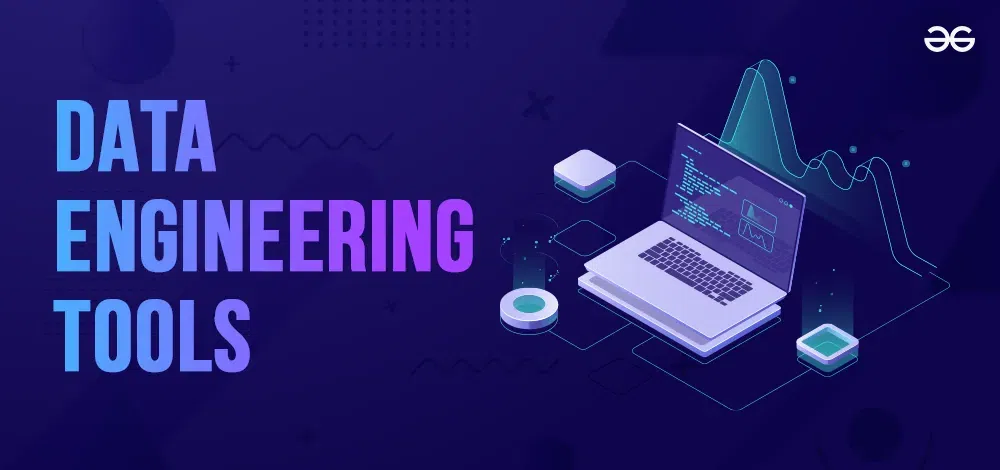Data engineering is a type of complex task that is used for making raw data usable to data scientists and grouping them within an organization. Data engineering is used to collect and analyze the data to get new or important insights which helps in transforming the business.
The data engineering tools are used for multiple purposes such as data analysis, data storage, data integration, workflow automation, and so on. Therefore in this article, a comprehensive overview has been provided about Data Engineering, data engineering tools, and the top 10 Data engineering tools that are popularly used by data engineers in 2024
What is Data Engineering?
Data Engineering is mainly defined as developing systems to enable the collection and use of data, this type of data is mainly used to enable the subsequent analysis and data science which involves machine learning. Therefore, it is particularly a practice of designing and developing systems for collecting, analyzing, and storing data at a scale. There are different data engineering tools that are used by modern businesses to provide a detailed solution by designing the best possible architecture to connect the data sources.
Best Data Engineering Tools in 2024
There are multiple Data engineering tools that are used by Data engineers for different activities such as data processing, data analytics, and so on. Therefore some of the best data engineering tools that will be used in 2024 are mentioned below:
1. Apache Spark
Apache Spark is one of the most popular Data engineering tools which is mainly used to handle the big data sets efficiently and share the processing tasks all around the various devices. It is an open-source distributed processing system that utilizes in-memory caching and optimized query execution for fast analytic queries against data of any size.
Key Features:
- With the help of Apache Spark real-time stream processing is possible.
- The apps created using Apache Spark can run up to 100 times faster in memory.
- Apache Spark mainly uses a Resilient distributed dataset which allows to keep the data in the memory transparently and read or write it to disc whenever necessary.
2. Snow Flake Data Warehouse
Snow Flake data warehouse is another cloud-based data analytics and service provider that helps customers migrate to a cloud-based solution quickly. This tool is a perfect fit for data engineering and data science. It is designed with a patented new architecture to handle all data and analytics.
Key Features:
- By using Snow Flake users can establish an infinite range of virtual warehouses, therefore they are scalable.
- It offers data security features such as block lists and IP allow, multi-factor authentication, and so on.
- The snowflake features built-in automated query optimization by using a query optimization system.
3. Power BI
Power BI is one of the popular tools, developed by Microsoft which mainly offers both cloud-based and desktop applications for sharing reports and dashboards. It has the ability to transform and visualize the data. It also provides the users with different technical skill levels such as Power BI Desktop, Power BI Mobile, and Power BI Service.
Key Features:
- A real-time data refresh feature is provided by Power BI.
- Drag and drop report builder feature is also provided.
- With the help of Power BI sharing the reports and dashboards with the other team members becomes easy.
4. Tableau
Tableau is a data engineering tool that focuses on usability and for non-technical users. This tool allows the users to answer pressing questions within seconds. It can integrate with different applications by using the pre-built data connectors, along with visualization and data discovery capabilities.
Key Features:
- Tableau consists of data connectors for each and every kind of data source.
- A real-time data analysis feature is provided by Tableau.
- Tableau also consists of drag-and-drop functionality.
5. Amazon Redshift
Amazon Redshift is a type of cloud-based data warehousing and data management solution that is famous for collecting datasets, searching the trends and anomalies, also helps in generating important information, and so on. It is one of the popular and ideal tools for vast volumes of data in multiple data houses by using modern business intelligence solutions.
Key Features:
- Amazon Redshift helps in boosting the outcomes by integrating with multiple third-party services which helps the users to analyze and visualize the data.
- It uses machine learning to deliver high throughout.
- This tool also delivers fast query performance on datasets.
6. Apache Kafka
Apache Kafka is one of the open-source distributed streaming systems that is mainly used for stream processing, data integration at scale and real-time data pipelines. It enables the application to consume, publish, and process high volumes of record streams in a fast way. Apache Kafka stores various events.
Key Features:
- Apache Kafka provides a simple message queue interface on top of its append-only log-structured storage medium.
- It is used to develop real-time streaming data pipelines and applications to adapt the data streams.
- This tool also offers an important feature that safeguards the cluster from machine or node failure.
7. Apache Hive
Apache Hive is a type of Hadoop-based data management and warehouse tool that mainly performs data processing and analytics extraction by using a SQL-like framework. It also helps in optimizing the query execution due to its new capabilities such as materialized view rewrites and automated query caching.
Key Features:
- Hive 3 can access the data freely across Apache Kafka and Apache Spark.
- Users can use workload management to form resource pools and also to manage resources to meet the demands.
- Hive consists of enhanced security features.
8. Azure Data Factory
Azure Data Factory is a type of serverless fully managed data integration solution that is used for processing, gathering, and modifying all the data at a scale. It is one of the best option for migrating existing ETLs and this tool also consist of multiple use cases in any of the industries for various tasks such as data engineering workflows, operational data integration, and so on.
Key Features:
- Data transformation and movement activities, and data flow transformation are some of its features.
- It allows the users to move ETL operations to Azure from on-premises Data lakes quickly.
- This tool also helps users to transfer large data volumes to the cloud.
9. Azure Databricks
Azure Databricks is another famous Data engineering tool that enables an open data lakehouse in Azure. It is optimized to store all the data on the simple open lakehouse and unify all the AI and analytics workloads. Therefore, it is a jointly developed data and AI service from Microsoft and Databricks for data science, engineering, analytics, and machine learning.
Key Features:
- This tool is used to help the data engineers work and collaborate on real-time coding in notebooks that support SQL, Scala, R, and Python.
- It consists of a lot of tools for most used tasks such as Data scheduling, management, managing security, and so on.
- This tool also offers auto-scaling, auto-terminating options, collaborative workspaces, and so on.
10. Apache Airflow
Apache Airflow is used for managing, scheduling, and developing the data pipelines more easily by the data engineers. It also allows smooth orchestration of data pipelines and therefore this is the reason why it is one of the best tools for data engineering workflows.
Key Features:
- Apache airflows allow the users to establish a granular workflow and also to monitor the progress.
- By using Apache Airflows users can easily upgrade airflow by utilizing plugins to add additional menu items to the user interface.
- It also offers a large range of connectors to external systems.
Conclusion
Data engineering tools are mainly used by data engineers to create the data pipelines that source and transform the data into the structure that is needed for the analysis purpose and to transform the unstructured or raw data into a useful one. These data engineering tools are used by the modern business for multiple purposes. Therefore in this article, detailed knowledge has been provided about data engineering and the top 10 data engineering tools in 2024.
FAQs
What do you mean by Data Engineer?
A data engineer are the type of people who develops, optimizes and maintains the data infrastructure for data acquisition, processing, access and storage. The data engineers are the individuals who mainly builds the pipelines which convert the raw data into an useful one.
Which tools are popularly used in Data Engineering?
Some of the tools which are popularly used in Data engineering are – Apache Kafka, Apache Spark, Snowflake, Tableau, Apache Airflow, Azure data factory, Power BI and so on.
What is the popular language in Data Engineering?
There are many different language which are used in data engineering but Some of the best language which are used data engineering are – Python and SQL.





